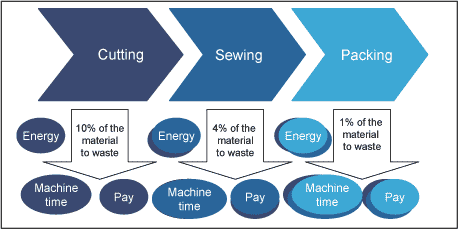|
Environmental Shareholder Value 8 Working capital investments8.1 Environmental Management Accounting Working capital investments reduce the free cash flow, but like investments in fixed assets, they are required for the company to carry out its activities and create earnings. Working capital investments cover for example consumption of materials, pay, and ongoing maintenance. 8.1 Environmental Management AccountingThere is a large number of relationships between environmental initiatives and the working capital investments of companies. Some are very obvious and will be clear from most companies' management accounting systems, while others are hidden in large cost pools. Because of this lack of transparency, it may thus be difficult to assess how the environmental work of the company affects the working capital investments and thus also Shareholder Value. There are, however, methods to create greater transparency in relation to companies' operational environment costs. Together, these methods are called Environmental Management Accounting (EMA). The central purpose of Environmental Management Accounting is to link the environment and management accounting closer together and thus provide management with information on the relationship between environment/energy and finance, so that it is able to make better decisions that save money and lead the company towards its goals in a speedier and more efficient manner; the decisions that provide the most cost-effective solution for society when achieving environmental objectives. Environmental Management Accounting may be based on the theory of Activity-Based Costing where all types of cost and income are calculated in relation to selected activities so that it becomes clear where there is potential for saving or change. This also applies to Environmental Management Accounting because it relates costs and income to environmental activities. The next section gives examples of the types of costs. 8.2 Environmental working capital investmentsIt is no surprise in relation to management accounting that it can be problematic to give a general adequate definition of environmental working capital investments or operating costs. For example, maintenance costs, production costs and indirect costs are typically defined differently in different companies. The same may apply in relation to the financial environment information where some costs and income amounts are clearly related to the environment, some costs and income amounts are clearly not related to the environment, and some costs and income amounts are in a "grey area". This section describes a number of cost types and their connection to the environment. 8.2.1 Operation of environmental plants and environmental workSome of the costs that are clearly related to the environment are direct costs of the operation of environmental plants like wastewater treatment plants or of the environmental work carried out in the company. This also applies to costs of environmental certification or similar. Such costs may include chemicals, water and electricity for plants as well as wages for staff participating in environmental work. As applies for investments in fixed assets, the working capital investments of environmental plants will only increase the free cash flow if, in operation, it is possible to save taxes on discharges or sell CO2 quotas. The costs of the work with environmental management in a broader sense may, however, pay for themselves in various different ways. Because environmental work aims at reducing resource consumption and emissions, there is a possibility that the projects also entail financial benefits from optimisation of production processes. 8.2.2 ResourcesThe most evident connection between the environment and working capital investments is the consumption of materials and energy. From both an environmental and a cost-related point of view, the consumption of materials and energy must be as low as possible per product. Environmental projects focusing on resource savings will also lead to cost savings and thus improved Shareholder Value. Since the costs of materials and energy are usually registered, these types of savings will be clearly identifiable in the management accounting system. Therefore, this is typically the first type of project to be implemented in companies introducing environmental management. 8.2.3 Indirect costsHowever, several types of cost may be reduced when resource consumption is made more efficient than is immediately apparent from management accounting. The figure below shows a simple production process for a clothing manufacturer. In each of the three process steps, part of the fabric is cut off or spoiled so that is becomes waste. In this process, the company incurs costs for the materials proper, but energy, machine time and pay have also been consumed to process the material that becomes waste.
Figure 5: Hidden environmental costs of waste generation in a clothing manufacturer The total costs of losses to waste are thus significantly higher than the costs of the materials and the taxes to be paid for waste removal which are the factors registered in most companies. As a consequence hereof, a reduction of waste arisings will also mean significantly greater financial savings, which is important to consider in connection with investments in projects for waste reduction or when the costs of environmental work are assessed. 8.3 SummaryOn the face of it, working capital investments reduce the free cash flow, but if the environmental plants and the environmental work create tax savings and savings on other operating costs, these environmental working capital investments may have a positive influence on the bottom line. In many companies, the operating costs are related to environmental conditions hidden in overall cost pools that make it unclear what the individual environmental initiatives lead to in terms of financial savings on working capital investments. Until greater transparency has been achieved in the cost structures, it is difficult for management to assess the impact of the environmental initiatives on working capital investments and, ultimately, on Shareholder Value. With greater transparency, the company will be able to supplement its accounting information with information indicating how the working capital investments have developed as a consequence of environmental work and thus to justify its environmental initiatives to investors.
|
